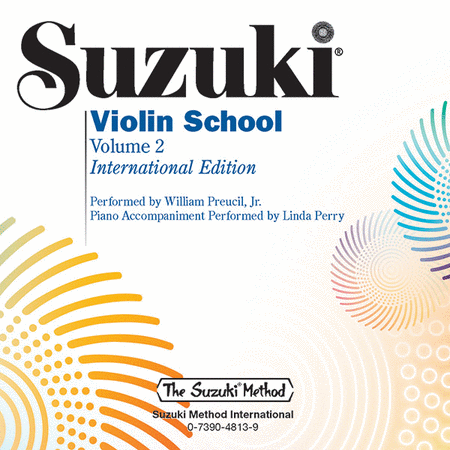Suzuki Violin School, Volume 2
International Edition
Details
Description
SKU: AP.47076
Volume 2. International Edition. By Linda Perry and William Preucil Jr. This edition: Performance/Accompaniment CD; International. Method/Instruction; SmartMusic; String - Violin (Suzuki); Suzuki. Suzuki Violin School. CD. Alfred Music #00-47076. Published by Alfred Music (AP.47076).ISBN 9780739048139. UPC: 038081539768. English.
Teach violin with the popular Suzuki Violin School. The Suzuki Method of Talent Education is based on Shinichi Suzuki's view that every child is born with ability, and that people are the product of their environment. According to Shinichi Suzuki, a world-renowned violinist and teacher, the greatest joy an adult can know comes from developing a child's potential so he/she can express all that is harmonious and best in human beings. Students are taught using the mother-tongue approach. Each series of books for a particular instrument in the Suzuki Method is considered a Suzuki music school, such as the Suzuki Violin School. Suzuki lessons are generally given in a private studio setting with additional group lessons. The student listens to the recordings and works with their Suzuki violin teacher to develop their potential as a musician and as a person.
This CD of the Suzuki violin method, Volume 1 features recordings by William Preucil Jr., and piano accompaniments by Linda Perry, as well as piano accompaniments recorded alone.
Titles: Study Points for Volume 2 * Chorus from Judas Maccabaeus (Handel) * Musette, Gavotte II or the Musette from English Suite III in G Minor for Klavier, BWV 808 (Bach) * Hunters' Chorus from 3rd Act of the Opera Der Freischutz (Weber) * Long, Long Ago (Bayly) * Waltz, Op. 39, No. 15 for Piano (Brahms) * Bourree from Sonata in F Major for Oboe, HHA IV/18, No. 8 (Handel) * The Two Grenadiers, Die beiden Grenadier, Op. 49, No. 1 for Voice and Piano (Schumann) * Theme from Witches' Dance (Paganini) * Gavotte from Mignon (Thomas) * Gavotte (Lully) * Minuet in G, Wo0 10, No. 2 (Beethoven) * Minuet from Sei Quintetti per Archi No. 11, Op. 11, No. 5 in E Major (Boccherini).
This title is available in SmartMusic.
The International editions include an updated title page that designates the book as the International Edition.
About Suzuki Method
The Suzuki Method is based on the principle that all children possess ability and that this ability can be developed and enhanced through a nurturing environment. All children learn to speak their own language with relative ease and if the same natural learning process is applied in teaching other skills, these can be acquired as successfully. Suzuki referred to the process as the Mother Tongue Method and to the whole system of pedagogy as Talent Education. The important elements of the Suzuki approach to instrumental teaching include the following:an early start (aged 3-4 is normal in most countries); the importance of listening to music; learning to play before learning to read; -the involvement of the parent; a nurturing and positive learning environment; a high standard of teaching by trained teachers; the importance of producing a good sound in a balanced and natural way; core repertoire, used by Suzuki students across the world; social interaction with other children. Suzuki students from all over the world can communicate through the language of music.

 Share
Share